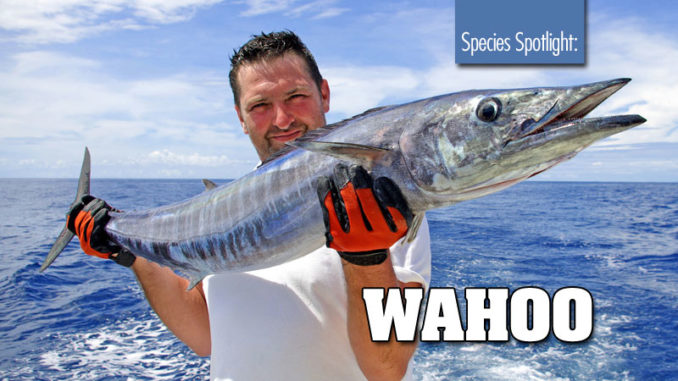
Wahoo are fast, hard-fighting, and tasty
Wahoo are among the fastest fish in the ocean, are hard-fighting, and are also one of the tastiest species in the sea. For those reasons and more, they are highly sought after by anglers throughout the world.
These fish are long and cylindrical, with toothy mouths. They have steel blue coloration along the upper portion of their bodies and are pale blue to silver below their lateral lines. Twenty-five to 30 blackish-blue vertical bars mark the length of the fish in an irregular fashion. These bars are more prominent in smaller wahoo. But they become very noticeable in even the largest wahoo when the fish is excited. Their scales are very small, and barely visible.
Wahoo have a movable upper jaw that is lined with many sharp teeth. The fish is sometimes misidentified as king mackerel or barracuda by inexperienced anglers. They are members of the Scombridae family, making them cousins to mackerels, tunas, and bonitos. They rarely travel in large schools, but younger fish often swim in loose groups of between two to 20 fish. On rare occasions, anglers have reported seeing wahoo in schools up to 100 fish.
These fish exist in the blue water oceans throughout the world. Recreational anglers fishing in offshore and nearshore waters often catch them. Trolling is one of the top tactics for catching these fish. Most experienced anglers switch between trolling at high speed and at low speed, depending on conditions and how the fish react on any given day.
These fish grow quickly, live short lives
Areas with deep, blue water that feature sunken rocks, wrecks, or live bottom are good areas to troll. No matter how deep the water is, spots with any sunken structure are good spots to look for wahoo, especially in water that ranges from 70 to 74 degrees. Floating weed lines are also good areas to target. Artificial lures and fresh ballyhoo are good baits.

Wahoo grow at a rapid rate, and have a short life span. Some studies with tagged, released, and re-caught wahoo have shown growth rates of as much as 22 pounds per year. Most die before 10 years of age. These fish can reach speeds of 60 miles-per-hour and can chase down a variety of intended prey, which includes numerous fish and squid. Fisheries biologists believe wahoo sometimes kill fish larger than themselves, shredding them into bite-sized chunks with their razor sharp teeth.
Anglers often find a giant stomach worm (Hirudinella ventricosa), in the bellies of these fish. However, the worms do not seem to have any negative impact on the fish, and also do not taint any part of the fish eaten by humans.
Wahoo spawn in every month of the year, and most reach sexual maturity by the end of their first year. The length of a spawning session varies widely between different regions of the globe, but most extend for long periods of time. Females release millions of eggs into the ocean each year, and males fertilize them as they float freely in the pelagic zone.
Wahoo can grow to more than 200 pounds
Wahoo are commonly referred to as hoos or ‘hoos by anglers across the southeastern United States. In other parts of the world, the fish are sometimes called ono, oahu, and peto.
Sara Hayward caught the world record wahoo, which weighed 184 pounds, in 2005 while fishing out of Cabo San Lucas, Mexico. A bigger, 202-pound wahoo was caught off the coast of Florida in 2016, but the fish was ineligible as a world record because three different anglers took turns reeling it in.
The South Carolina state record wahoo weighed 130-pounds, 5-ounces. R.J. Moore of Valdese, N.C. caught the fish out of Murrells Inlet in 1998. North Carolina’s state record wahoo, caught by Kevin Elwell in 1994 out of Ocracoke, tipped the scales at 150 pounds.

